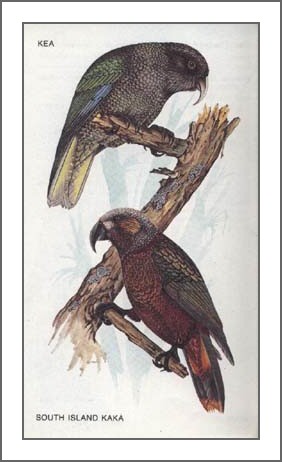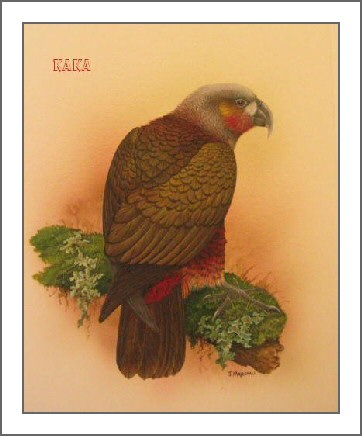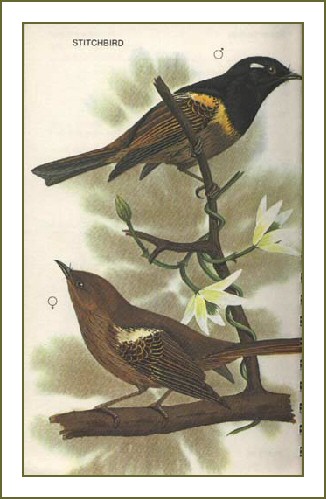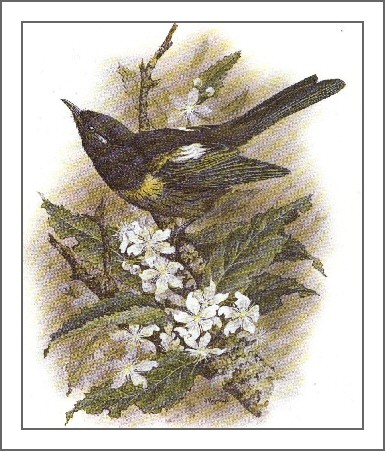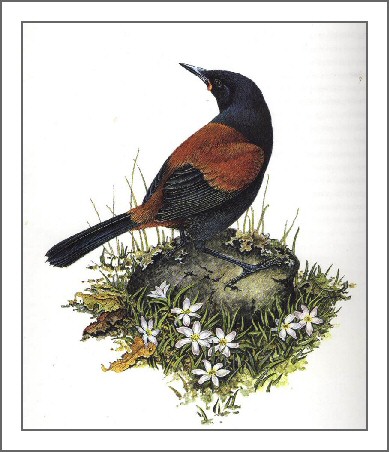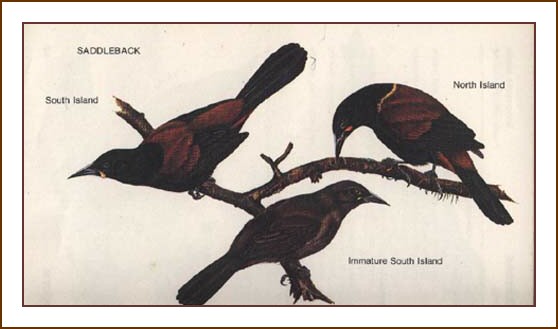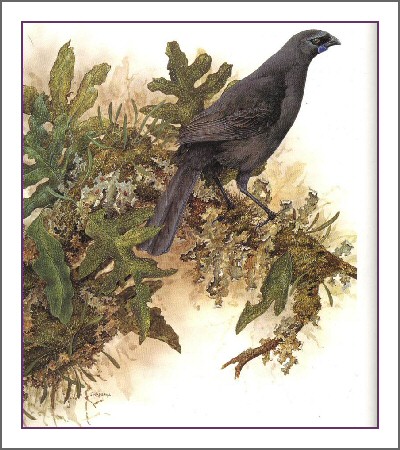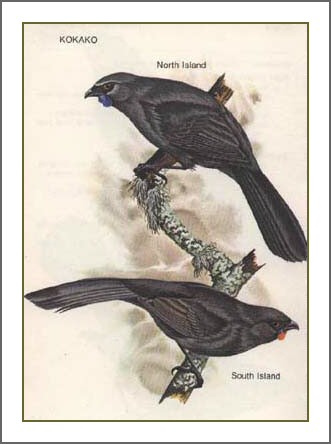

SCROLL DOWN TO FIND THE FOLLOWING BUSH BIRDS:
 (
from K is for KIWI, Reed)
(
from K is for KIWI, Reed)
'Let's have a party,' the Kea said. 'And his cousin, the Kaka, agreed. 'We'll celebrate all things beginning with K, and have a magnificent feed.' So they deck ed the trees with colourful food, like kakabeak, kowhai and kahikatea, and spread the ground with colourful Ks; it hadn't looked brighter all year. A kingfisher watched from a kauri tree, admiring the festive view, while kiwi shuffled off with his egg, before it was put on the menu.
![]()
KEA; KAKA; BUSH WREN; STITCHBIRD; SADDLEBACK;
KAKAPO; KOKAKO; EASTERN ROSELLA
![]()
KEA
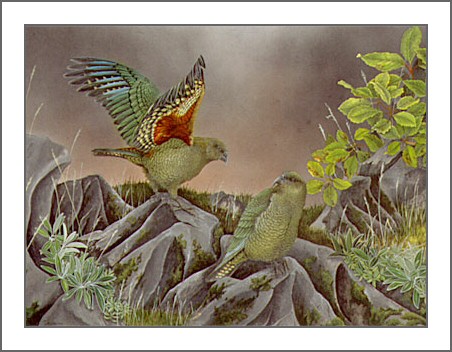
KEA Nestor meridionalis FAMILY: Nestroridae
Endemic and partially protected. Similar in size to the Kaka but mainly olive-green in colour with bright orange-red on the rump and under the wings. Their call is a harsh 'kee-a" called mainly in flight. Found only in the South Island, in high country and alpine from Marlborough-Nelson to Fiordland. Some birds will reach the coast during the Winter in Nelson and Westland. They are most common above the bush line but can also be found in native bush. Kea feed on fruit, nectar, roots, leaves, buds and insects. Breeding is from August to December. They nest on the ground in crevises or holes in logs. Sometimes leaves and twigs are used for nesting material. The eggs, 2-4, are white. Kea are renowned for their inquisitiveness and playfully destructive habits, such as destroying car or bike parts in mountain carparks.
![]()
KAKA
|
|
|
KAKA Nestor meridionalis FAMILY: Nestridae
Endemic, with two closely related sub-species, one in the Southern Islands and the other in the North Island. Fully protected.Same size as the Kea, generally chocolate-brown in the North Island and more green in colour in the South with red belly and grey crown. Their call is a loud "ka-ka" and a melodic whistle. Kaka are mainly confined to large areas of native bush and offshore islands such as Kapiti and Little Barrier Island. Foods consists of berries, nectar, seeds and grubs. Breeding is from November to January when they nest in hollow trees without any nesting material. The eggs, 4-5, are white.
![]()
SOUTH ISLAND BUSH WREN
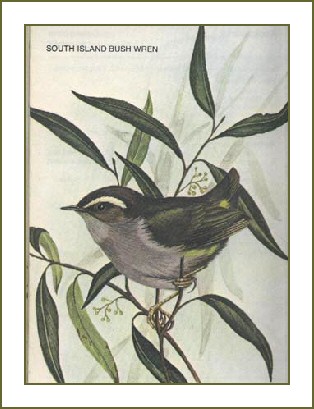
SOUTH ISLAND BUSH WREN Xenicus longipes FAMILY: Xenicidae
Endemic with two other sub-species. Fully protected. Larger than the Rifleman and generally darker all over, with a conspicuous eye-stripe. Bobbing of body upon landing. The call is a subdued trill. The Bush Wren is little known and extremely rare, although it was widespread in remote forested mountain areas of Tasman and Spencer Ranges, Westland and Otago. They feed generally among foliage on insects. Breeding is from November to December, the nest being pouch-shaped, closely woven with rootlets and lined with feathers, on or close to the ground. The eggs, 2-3, are white. The North Island Bush Wren is now presumed extinct.
![]()
STITCHBIRD / Hihi
|
|
|
STITCHBIRD / Hihi Notiomystis cincta FAMILY: Meliphagidae
Endemic and fully protected. Same size as the Bellbird, the Stitchbird is one of three honey eaters endemic to NZ. Originally Stitchbird were found mainly in the Southern North Island and major offshore islands. However, they are now confined to Little Barrier Island since the 1880s. Here they are well established. They are found in various types of forest and are attracted to nectar-bearing plants, such as Pohutukawa, Kohekohe and flax. They also feed on insects. Breeding is from November to December. The nest is made from tree-fern scales, rootlets and twigs, in holes in trees or branches. The eggs. 3-5, are white.
![]()
SADDLEBACK / Tieke
|
|
|
SADDLEBACK / Tieke Philesturnus carunculatus FAMILY: Callaeidae
Endemic to NZ with two closely related sub-species shown in the plate. Fully protected. Same size as the Tui. All black save for a chestnut coloured 'saddle' on the back. One of the 3 wattlebirds found in NZ. Saddleback have orange wattles which turn redder during breeding. The North Island sub-species has a pale stripe seperating the black nape and chestnut back. Saddlebacks are poor flyers, with short flights and hopping from branch to branch. The North Island species was formerly abundant on the mainland and offshore islands but are now confined naturally to Hen Island. They have been succesfully liberated on Cuvier, Fanal, Red Mercury and Middle Chicken Islands. The South Island species was also abundant on the mainland and major offshore islands, but under threat of extinction were transferred to Stage and Kaimohu Islands. Subsequent liberations were made to other islands from these stocks. Saddleback feed on the forest floor or low tree trunks for invertabrates and fruits. Breeding is from October to January and the nest of twigs lined with finer material are in hollow trees or thick cover from the ground to 2mts. The eggs. 2, are pale grey or white with light brown spots and blotches concentrated at the larger end.
![]()
KAKAPO
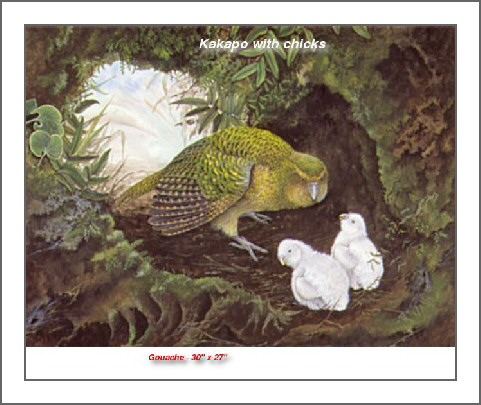
KAKAPO Strigops habroptilus FAMILY: Cacatuidae
Endemic and fully protected. The Kakapo is a very large parrot that is nocturnal and flightless. The voice has been described as a deep, hoarse booming, but the range of calls includes a variety of eerie coughs, squeals and grunts. The Kakapo is one of the rarest birds in NZ and is presently confined to a few valleys in Fiordland and a recently discovered population on Stewart Island. Some birds have been transferred to a vermin-free island in the Marlborough Sounds. Found in forest areas up to the snowline, they feed on a variety of grasses, leaves and berries. Breeding is from December to May and the nest is in a hollow in tree roots and under logs, or in crevises or deep burrows. The eggs, 3, are white. The female incubates the eggs and rears the chicks.
![]()
KOKAKO
|
|
|
Kokako Callaeas cinerea FAMILY: Callaeidae
Endemic with two closely related sub-species shown in right side picture. Fully protected. Twice the size of the Tui, the Kokako is dark bluish-grey all over, with disproportionately long and drooping tail and long strong legs. One of the 3 wattlebirds found in NZ. Bright blue wattles on the throat are on the North Island species while the South Island has orange and blue wattles and no pale line between the black of the face and the grey of the head, as on the Nth Island. Their call is a wide orchestral range of bell notes and the bird is usually heard rather than seen. The North Island species is relatively rare but widely distributed in pockets of unmodified native forest throughout the North Island. The South Island species is now extremely rare, if not extinct. They feed on fruits, flowers and leaves. Breeding is from November to March. The nest is a platform of branches and twigs lined with mosses and fern scales, usually in a tree fork or tight branches, up to 10mts above the ground. The eggs, 2-3, are pale stone-grey with brown and purple spots and blotches.
![]()
EASTERN ROSELLA
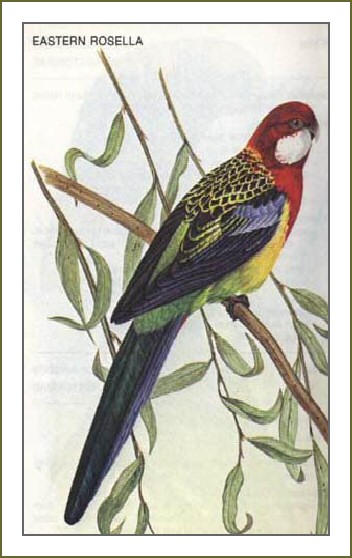
EASTERN ROSELLA Platycercus eximus FAMILY: Platycercidae
Introduced from escaped cage birds. Also found in Eastern Australia. Not protected. Strikingly coloured parrot about twice the size of a Parakeet. It has a very rapid wing beat when in flight and a prominent long tail. They are common in native bush north of the Waikato, also Western Wairarapa, Upper Hutt valley and Dunedin. They feed on seeds, berries, flowers and sometimes fruit. Nesting is in holes in hollow trees or branches. In Australia they breed from August to January. The eggs, 4-7, are white. The female only incubates.
![]()
/p>
nbsp;











